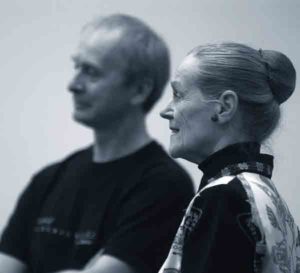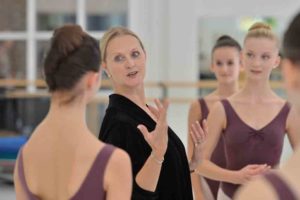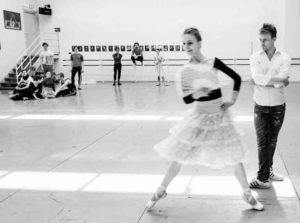The Evolution of Ballet Training: Insights from Masters of the Form - Vancouver Ballet Society
- Home
- Features 2015 - 2019
- The Evolution of Ballet Training: Insights from Masters of the Form

By Jennifer Fournier
Before her final performance with the National Ballet of Canada, in the title role of Giselle, Chan Hon Goh began her day as she had most days since she was a child — by taking ballet class. As she did the tendu exercise in company class, she thought about the words of her father and first teacher, Choo Chiat Goh: “Keep your heel on the floor until the very last second — until the toes have to stretch.” She had dedicated her life to mastering the art of ballet, her standards always increasing, and she would end her career still trying to do a perfect tendu.
“Class” has an almost sacred place in the ritual of a dancer’s daily life. Class is where, step by step, the essential building blocks of ballet are acquired, and where, even as a mature dancer, the aim is to continuously secure and refine technique. If the stage provides the opportunity to display mastery, class is a place where dancers must constantly push their limits.
“You have to face everything in class,” says Chan, who is now the director of Goh Ballet Academy in Vancouver. “You can’t be afraid of failure; you have to practise the side where you are weaker, you have to work on the things that are difficult with honesty and humility.” Class is both laboratory and lecture hall — a dancer’s humbling daily reckoning with the longstanding and unyielding principles of ballet itself. “You have to remember what ballet is built on. You can’t change the rules of the body; they will always stay the same,” says Nancy Kilgour, a master teacher and pedagogue who has taught at the Royal Ballet School and Canada’s National Ballet School, among others. Kilgour has a profound knowledge of these rules, and was a formative teacher for some of the 20th centuries’ great ballerinas, including Karen Kain, Alessandra Ferri and Darcey Bussell.

Photo: Courtesy of Alberta Ballet
Dancers have long sought out the best teachers: Antoine Bournonville brought his young son, August, to Paris to train with Auguste Vestris in 1820, and Diaghilev sent Serge Lifar to work with Enrico Cecchetti to learn the principles of classicism.
Writing in the 19th century, Carlo Blasis advised young dancers to “seek to place yourself under the direction of an experienced master, whose knowledge and talents will serve as true guides to perfection and point out the path that leads to pre-eminence.” Even in this age of YouTube, when young dancers can watch classes at the Vaganova Academy and learn variations on their iPhones, classical ballet — which requires of its practitioners a sophisticated understanding of movement, anatomy, musicality and theatricality — does not lend itself to being self-taught.
The “dancing master” has been integral to the form since the establishment by charter of France’s Academy of Dance in 1662. Until then, codes of comportment flowed directly from the king, and knowledge of them conferred membership in a privileged class. When King Louis XIV entrusted the maintenance of standards and the teaching of dance to a group of 12 individuals, ballet started to assume autonomy as an art form. These early masters were responsible for recording dances and choreographing divertissements for the king upon request, but their principal task was to develop dance as a system of knowledge that would provide a strong foundation of training.
Knowledge of anatomy, which was starting to flourish, became an important pedagogical tool. “Turnout machines,” a popular device that strapped the feet to rotating platforms, were abandoned once dancing masters recognized that turnout started in the hip joint, and advised that students do ronds de jambe and battements to increase rotation of the leg in the hip. Teachers also realized that postural alignment was achieved through internal strength rather than through external supports such as the corset, and began prescribing preliminary exercises to develop the muscles necessary to stabilize the core.
As ballet evolved into a field of study in the late 17th century, dancers began to devote more hours each day to practising the existing dance vocabulary of five positions of the feet and seven basic steps: plier, elever, sauter, cabrioler, tomber, glisser and tourner.
As Susan Leigh Foster observes in her Choreography and Narrative: Ballet’s Staging of Story and Desire, these basics had a built-in capacity to promote the achievement of new standards of proficiency with the addition of repetitions, embellishments and increased levels of difficulty. For example, once one mastered a cabriole “simple,” a double cabriole could be attempted; changements de pieds could be embellished with the use of arms and head or by beating the legs; and a quarter turn could become a double or triple pirouette.
By the 19th century, Blasis would exclaim that “the dancers of the early part of the last century were inferior to those who flourished toward the latter end of it, and still more to those of the beginning of the present age … That energetic execution, that multiplicity of steps, that variety of enchaînements and pirouettes were not then in practice, and the rising art, unadorned with these complicated embellishments, confined the performer within the narrow limits of simplicity.”
This exploration of the limits of technique transformed ballet into a form that bore little resemblance to its origins in 17th-century court dances. However, virtuosic tendencies were limited by these aristocratic origins, which favoured qualities such as ease, charm, lightness and grace. This is still mostly true today, and the greatest dancers were then, and are still, those who can perform extraordinary feats and make them look effortless. As August Bournonville succinctly put it in his Études chorégraphiques of 1861, “Noble simplicity will always be beautiful. The astonishing on the contrary soon becomes boring.”
Ballet teachers, much like the early dancing masters, address both principles of comportment and physical training in the earliest classes. Diane van Schoor, former ballet principal of the Royal Ballet Lower School, White Lodge, and an expert in the Cecchetti method, says, “Teaching classical ballet is the teaching of manners — impeccable manners denote respect, not only for the art form, but also respect for the masters and teachers you learn from.”

Photo: Brian Slater, courtesy of the Royal Ballet School
Van Schoor explains that a professional school should have a well-defined curriculum that allows the clear progression of work from junior to professional level. Leading children’s bodies through this progression requires a deep and fundamental knowledge of artistic and physical development. Kilgour believes the hardest thing for a teacher to learn is this “build-up,” the training of a dancer from the ground up, which she says the great teacher Agrippina Vaganova perfected. “You can’t teach by giving young children a ballet class in miniature.”
Magdalena Popa, former prima ballerina at the Opera of Bucharest and principal coach of the National Ballet of Canada, recalls her time studying at the then Leningrad Choreographic Institute, now Vaganova Ballet Academy. Popa’s teacher was Vaganova’s assistant, Naima Valievna Baltacheva. “She had the most beautiful port de bras, and I learned how to move the arms so that the expression goes all the way to the fingernails,” says Popa.
“The training had a strong discipline, but the most important thing was co-ordination. The moment you do a position, it doesn’t matter what, the body has to be completely alive. Every moment was a co-ordination between legs, arms, head, everything. I kept that all my life and now I pass it on.
“I also learned how to accept criticism, to learn from it and solve the problem. Nobody told me how fantastic I was — no, I don’t remember that — but they told me what I needed to work on without putting me down.”
Today, there are many training methods and techniques, including the French School, Vaganova, Balanchine, Cecchetti, Bournonville and the Royal Academy of Dance. Each one has been influenced to some degree by other schools. For example, the fiery Italian dancer and ballet master Cecchetti brought a fresh spirit to the ballet when he arrived at the Imperial Theatre in St. Petersburg. Bournonville’s intensive studies in Paris with Vestris transformed him into a virtuoso whose sweeping movement quality, precision and electrifying jumps revolutionized the Danish style. In turn, Bournonville’s pupil, the Swede Christian Johansson, brought his teacher’s ideas to Russia where he passed them on to Anna Pavlova, Tamara Karsavina and Vaganova. As van Schoor notes, “Ninette de Valois took the best from the Italian, Russian and Danish methods and incorporated all to create the English School and, ultimately, the English style.”
Nevertheless, a school must have its own individual stamp. “It could be Vaganova, Bournonville, Cecchetti … the method is a starting point to give you a solid ground to build on,” says Nikolaj Hübbe, former principal dancer of the Royal Danish Ballet and New York City Ballet, and now artistic director of the Danish company. “Learning to dance ballet is like learning a language. Now we are talking about form, because ballet is so stylistic — you take the form and shape it with style.”
Hübbe says that he prefers a one-method scholastic approach to the child, which provides a strong technical foundation that can then be applied to a variety of styles. “Dan-cers have to know the form must one day be used to dance La Sylphide, Kylián, George Balanchine,” but a school can’t stress every technical and stylistic idea in training “or the dancer becomes a prince of everything, king of nothing.”

Photo: Christian Als
Bournonville’s exercises are taught to the Royal Danish Ballet School’s students in a weekly class starting at age 11. “The exercises are extremely prescriptive and diagnostic: this is for speed, this is for sustained strength, all to differentiate and educate the musicality of the body,” says Hübbe.
Thomas Lund, director of the Royal Danish Ballet School, says that students also have classes that give a wider range of exercises necessary to adapt to various styles of choreography. For Lund, introducing new styles is a matter of timing. “If you do it too early, you end up without one full language. We try to balance the development of the school [curriculum] with our traditional one — if you have a strong identity, you don’t have to be afraid to lose it.”
Lund is very conscious of preparing his students for the realities of the job market. “Most of our teachers are from the Danish tradition, but we visit the Paris Opera Ballet, the Royal Ballet, the annual Assemblée Internationale at Canada’s National Ballet School, and we learn and share ideas. We have to go to other places, we have to keep up an international level of technique.”
Bournonville, though his approach to training even during his own time was considered “old school,” wrote, “It is up to the artist himself to give the style and modern touch, and to adapt them to different situations.” Van Schoor believes that if Cecchetti were here today, he would have evolved his own method. “He was a progressive thinker and bodies have changed — they are more lithe, more physical.”
Tracing the evolution of a school’s training is a bit like examining a family tree in which dancers, teachers and choreographers all play a part, as illustrated by the Royal Danish Ballet. When Bournonville taught daily class, he gave a short and strenuous barre to serve as a warm-up for the centre where students would dance his variations, including his many enchaînements for ballon and elevation. These classes were taught largely as he gave them until 1951, when the Vaganova-trained Vera Volkova came to Copenhagen to teach the company and reorganized the school. Hübbe says that Harald Lander, then artistic director of the Royal Danish Ballet, had invited Volkova to Denmark so that the Danish ballerina Toni Lander (who was also his wife) could benefit from the Russian training of port de bras. (Ironically, Harald Lander was fired just as Volkova arrived.)
Until Volkova’s arrival, rotation had not been emphasized in Danish training because Bournonville believed that excessive turnout was “uncalled for,” Hübbe says. With the Russian influence, leg extensions became higher, and the pelvis more lifted to make room for the hip joints and the use of the inner thighs.
Indirectly, the arrival of Volkova shaped the direction of ballet in America as well. “Because Volkova only spoke Russian and English, Stanley Williams was her translator. That is how Stanley started teaching, learning from Volkova.” Williams then travelled to the United States, where he taught at the School of American Ballet and was influenced by Balanchine. When he returned to Denmark, the barre became longer. Williams would become a legendary ballet master and train many generations of dancers at New York City Ballet.
Back in Denmark, Volkova’s arrival had not been without controversy in a company whose traditions had been preserved since the Romantic era; some insisted the Danish style and technique would be lost. However, Hübbe explains that a baby boom as a result of curfews during the Second World War had led to an influx of applications to the Royal Danish Ballet School, and the larger talent pool had produced dancers with better bodies. New choreography for the company also contributed to the shift. “The repertoire became more diverse when Niels Bjorn Larsen, the company’s artistic director, brought in Roland Petit, Balanchine and Cullberg, and through the influence of international choreographers the training started changing, not deliberately, but through osmosis.”
Ballet masters play an essential part in the lineage of a school’s tradition as it is passed from one person to another. Kilgour, who began her teaching career at the National Ballet School, says, “I learned about musicality from Celia Franca [founder of the National Ballet of Canada], the importance of passion for dance from Eugen Valukin [a former Bolshoi dancer who taught at Canada’s National Ballet School], and how to teach from Betty Oliphant [the school’s co-founder].” But this knowledge can easily be lost when links between generations are broken. She advises young teachers that it is imperative to observe other teachers.

Photo: Sian Richards, courtesy of the National Ballet of Canada
Kilgour had the opportunity to watch Mikhail Baryshnikov in Alexander Pushkin’s graduating class at the Leningrad Choreographic Institute on a visit to the Soviet Union in 1965. She recalls thinking, “He’s so talented, but he only does half the barre.” Baryshnikov, she learned later, only did half the exercises because Pushkin believed his muscles needed the opposite of what the other students needed. Kilgour worries that teacher-training courses, with their emphasis on theory, neglect the importance of teaching that there are different types of dancers.
“Good teachers have long recognized that their responsibility is to develop the qualities and eliminate the imperfections which everyone, not even excepting the greatest of talents, is obliged to combat,” Bournonville wrote.
Hübbe concurs. “The greatest thing for a teacher is to be able to unlock a technique and expression, no matter what body type, as a tool for expressing music, turning in pirouettes, lifting a partner, going into a room with a choreographer or doing an adage.”
Perhaps the most mysterious aspect of training is how a dancer becomes an artist. There is no question this transformation requires a strong base in all of the arts. According to Blasis, the study of drawing and music were “almost indispensable to make a perfect dancer.” At the Vaganova Academy, Popa studied the history of art and sculpture, the history of music, and historical, character and modern dance. “When I started learning roles, there was a class for how to express a role. I would also read about the ballet, listen to the music, and we all took piano lessons and learned the score. Some people have a natural instinct, but instinct is not enough, you need knowledge.”
At the Royal Danish Ballet, mime is an integral part of the tradition, and students take drama classes from the ages of five to eight, and understand that along with a strong technique they must learn to be expressive onstage. Because Bournonville used children in his ballets, the students grow up in the theatre and can watch and learn from the older dancers when they are performing together. “We try to find the essence not by acting, but by being the part. I don’t know if ballet ever becomes completely natural,” says Lund, “but we don’t express from the outside in, but the inside out.”
Another famous Dane, Erik Bruhn, says in Erik Bruhn, Danseur Noble, “If you don’t have the confidence to show what you feel through technique, then you remain a product.”
“I know what Erik means by ‘product,’” says Hübbe, “and it is a hard word when we are dealing with human beings. But there is something cut and dried about training a dancer. You can’t jump the production line and go straight to art.”
For Popa, the ability to express oneself through dance is another way of describing talent, something you can develop, but not necessarily instill. “There are two parallel tracks in becoming a dancer. The first is the development of knowledge — of what to do and how to do it; and the second is the development of expression — or talent,” says Popa.
“You can’t teach someone to dance as you danced. Dancers must use the knowledge you give to be themselves.”

Photo: Courtesy of the Royal Danish TheatreDI
